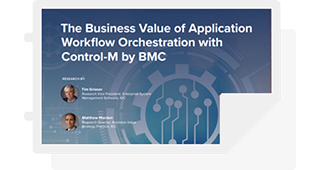Whether you’re part of an IT ops team or an application developer, you’ve certainly heard about automation as a way to improve the software development lifecycle, lower IT costs, and save money.
If automation means setting up a single task to run on its own, then orchestration means automating a lot of things at once: multiple automated tasks involving multiple systems.
For most organizations, orchestration is vitally important to advancing technologically. And IT departments use workflow orchestration tools to improve system and application performance in several critical areas:
- Ensuring application reliability
- Realizing significant efficiencies in monitoring applications and digital services
- Delivering more innovative applications
- Accelerating the application development lifecycle
- Achieving better business results
However, not all workflow orchestration tools are alike. To get an in-depth look at how Control-M, BMC’s application workflow orchestration solution, steps up to today’s DevOps challenges, IDC recently conducted a formal, comprehensive review of the technology.
The resulting white paper, titled The Business Value of Application Workflow Orchestration with Control-M by BMC, is based on interviews with seven IT leaders from large, enterprise-level organizations. The participating firms come from several vertical sectors, have an average workforce of more than 19,000 employees and produce annual revenues totaling around $7.5 billion on average. Each interviewee reported having direct “experience and knowledge about Control-M’s benefits.”
Here’s what IDC learned:
Control-M handily addresses the complexity of large agile environments
Organizations today are rapidly deploying digital business applications for their most important customer-facing services, such as e-commerce.
“Many digital applications are built from a complex set of components deployed across multiple environments,” the report states. “This type of deployment architecture often requires navigation of intricate workflows for successful operation.”
Control-M streamlines complex application workflows by making it easier to define, schedule, manage and monitor workflows across on-premises, private, and public cloud environments. According to those interviewed by IDC, Control-M offers organizations these and other powerful features:
- Core automation functions and capabilities that allow IT teams to replace manual scripting with automated workflow orchestration and data integration.
- Self-service web-based or mobile access which allows users to monitor and manage their own workflows at a granular level.
- Jobs-as-Code support with Automation API, a feature that enables developers and DevOps engineers to code jobs within the agile application release process for greater consistency within development, test, and production processes.
- Data pipelines that deliver consistent service levels by orchestrating and automating complex workflows across on-premises, hybrid, and multi-cloud environments.
- Better managed file transfers aligned with related application workflows.
Control-M also supports SLA management with automated alerts, archiving for problem analysis, audit compliance, and integrated reporting.
These robust capabilities make Control-M an essential resource for organizations that deploy it. In fact, of the organizations participating in the study, the platform undergirds around 73 percent of total company revenue on average. Plus, interviewed organizations reported having “an average of more than 400 users who rely on Control-M to do their jobs,” including DevOps and application development teams, with an average of 200 team members using it “on a regular basis.”
Control-M quickly pays for itself
Organizations using Control-M:
- Get an average annual benefit of $10.38 million
- Achieve ROI in eight months
- Earn a 539% ROI In three years
Study participants attribute these cost savings to four key Control-M benefits: significant efficiencies in monitoring applications and digital services, the ability of development teams to expedite the delivery of new applications, increased revenues due to better customer service, and the ability to more efficiently handle risk, including auditing for compliance.
As one participant reported, “We did a value assessment last year and compared Control-M against four other vendors. No one came close to touching Control-M. On a yearly basis, we’re probably seeing a 400 to 600 percent return on our investment.”
Application monitoring is simplified
IDC reports that Control-M allows IT teams to “shift away from manual and resource-intensive monitoring activities and instead… work more efficiently, monitor more applications, and deliver higher-performing applications to employees and customers.”
Of note, the white paper states that Control-M delivers “significant” efficiencies in the areas of workflow management, file transfer processes and SLA management, all of which translate into higher productivity. IDC data shows that on average organizations require the “equivalent of almost 37 fewer staff members’ time” for monitoring responsibilities, allowing team members to instead shift their focus to more innovative pursuits that align with business strategies.
According to a study participant, “In a worst-case scenario, we’d need to hire hundreds of people without Control-M because it is particularly good at SLA management for workflows and provides visibility in terms of time perspective and workflow status.”
DevOps processes are streamlined as well
For organizations in the study, Control-M has proven critical to their organizational shift into a DevOps approach and their ability to achieve a continuous integration and continuous development (CI/CD) model.
Control-M benefits developers in vitally important ways, including reducing the complexity of delivering “timely and robust application functionality to users and customers.” As a result, study participants reported the ability to develop 50 percent more applications while “improving the velocity of application delivery by 32 percent with Control-M.”
One IDC interviewee added, “Control-M allows us to tear down and build up development processes without having to upgrade every time there’s something new. It’s all automated. . . The number of development errors is much lower now. Ten percent of releases go back with errors compared with probably 40 to 50 percent before Control-M.”
The power of data is unleashed
With Control-M implemented, study participants have been able to achieve the 360-degree view of data pipelines needed to extract the kind of business insights that improve customer experiences. This expanded visibility and data access allow for more precise and timely queries, the white paper reports, which in turn have allowed study participants to gain business benefits from their data faster.
As one organization in the study reported, “[Our] data scientists are probably around 75 percent more efficient [using Control-M] because they did not have access to all of the data before, but now automatically have it.”
Businesses are digitally transformed
According to IDC, organizations today need “rapid and efficient definition, execution and monitoring of application workflows” to keep pace with innovation and meet the ever-advancing digital expectations of the consumers they serve.
Ultimately, IDC research shows that automation and orchestration solutions designed to perform at speed and scale are important “enablers” of complex distributed applications, “bringing efficiency, stability and visibility for stakeholders that include IT ops, DevOps, development, and line-of-business users.”
Control-M delivers on the promise of end-to-end workflow orchestration by allowing IT organizations to optimize both their human and technological resources. When Control-M is deployed across complex agile environments, development processes are expedited, IT ops teams are freed up to focus on strategic initiatives, and user experiences are infused with all the speedy, seamless utility today’s digital-first consumers expect.
Get the fully story on how Control-M has revolutionized application monitoring and development for industry-leading global firms. Download IDC’s report here.







